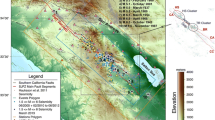Abstract
This paper presents a new ground motion prediction equation for the estimation of generalized interstory drift spectrum (GIDS). This parameter estimates, through an approximate method, the maximum interstory drift ratio in multistory buildings responding elastically to a given ground motion record. The models presented by this study is developed empirically by regression of the database that was selected from the NGA-West 1 for fault rupture distances of <60 km. The dataset comprised 851 corrected and processed strong-motion records of earthquakes between M w 5.2 and 7.9. The model is bass on a function of earthquake magnitude, distance from source to site, local average shear wave velocity, nonlinear soil response, sediment depth, rupture dip, faulting mechanism, and hanging-wall effect. This equation was derived from a stable algorithm for regression analysis called mixed-effects model. The algorithm was used to develop ground motion prediction equation for the estimation of GIDS in three different lateral resisting systems with oscillator periods ranging from 0.05 to 5.0 s. These structural systems with bending lateral deformation (shear walls), shear lateral deformation (moment-resisting frames), and hybrid lateral deformation (combination of moment-resisting frames and shear walls) are selected to maintain a general prospect with respect to the effect of the seismic source and site parameters on GIDS. The results showed that increasing shear wave velocity causes a decrease in the influence of the type of lateral resisting system on the maximum interstory drift ratio. Moreover, a comparison of different systems indicates that maximum interstory drift ratio of moment-resisting frames is less dependent on the distance from causative fault than shear wall structure.













Similar content being viewed by others
References
Abrahamson NA, Silva WJ (1997) Empirical response spectral attenuation relations for shallow crustal earthquakes. Seismol Res Lett 68:94–127
Abrahamson NA, Silva WJ (2008) Summary of the Abrahamson and Silva. NGA ground-motion relations. Earthq Spectra 24:67–97
Abrahamson NA, Youngs RR (1992) A stable algorithm for regression analyses using the random effects model. Bull Seismol Soc Am 82:505–510
Ambraseys NN, Douglas J (2005) Equations for the estimation of strong ground motions from shallow crustal earthquakes using data from Europe and the Middle East, Horizontal peak ground acceleration and spectral acceleration. Bull Earthq Eng 3:1–53
Biot MA (1941) A mechanical analyzer for the prediction of earthquake stresses. Bull Seismol Soc Am 31:151–171
Boore DM, Atkinson GM (2008) Ground-motion prediction equations for the average horizontal component of PGA, PGV, and 5 %-damped PSA at spectral periods between 0.01 s and 10.0 s. Earthq Spectra 24:99–138
Bozorgnia Y, Hachem MM, Campbell KW (2010) ground motion prediction equation (“attenuation relationship”) for inelastic response spectra. Earthq Spectra 26:1–23
Campbell KW, Bozorgnia Y (2003) Updated near-source ground-motion (attenuation) relations for the horizontal and vertical components of peak ground acceleration and acceleration response spectra. Bull Seismol Soc Am 93(1):314–331
Campbell KW, Bozorgnia Y (2008) NGA ground motion relations for the geometric mean horizontal component of peak and spectral ground motion parameters. PEER 4:112
Chiou BSJ, Youngs RR (2008) An NGA model for the average horizontal component of peak ground motion and response spectra. Earthq Spectra 24:173–215
Choi Y, Stewart JP (2005) Nonlinear site amplification as function of 30 m shear-wave velocity. Earthq Spectra 21:1–30
Eroğlu T, Akkar S (2010) Lateral stiffness estimation in frames and its implementation to continuum models for linear and nonlinear static analysis. Bull Earthq Eng 9:1097–1114
Gengshu T, Pi Y-L, Bradford MA, Tin-Loi F (2008) Buckling and second-order effects in dual shear-flexural systems. J Struct Eng 134:1726–1732
Guo J, Chen J, Bobet A (2013) Influence of a subway station on the inter-story drift ratio of adjacent surface structures. Tunn Undergr Space Technol 35:8–19
Housner GW (1947) Characteristics of strong motion earthquakes. Bull Seismol Soc Am 37:19–31
Iwan WD (1997) Drift spectrum, measure of demand for earthquake ground motions. J Struct Eng 123:397–404
Kemptona J, Stewart J (2006) Prediction equations for significant duration of earthquake ground motions considering site and near-source effects. Earthq Spectra 4:985–1013
Kim J, Collins KR (2002) Closer look at the drift demand spectrum. J Struct Eng 128:942–945
Miranda E, Akkar SD (2006) Generalized interstory drift spectrum. J Struct Eng 132:840–852
Miranda E, Taghavi S (2005) Approximate floor acceleration demands in multistory building. I: formulation. J Struct Eng ASCE 131:203–211
Mollaioli F, Mura A, Decanini L (2007) Assessment of the deformation demand in multi-storey frames. J Seismol Earthq Eng 8:195–211
Shodja A, Rofooei F (2014) Using a lumped mass, non-uniform stiffness beam model to obtain the interstory drift spectra. J Struct Eng 140:04013109
Somerville PG, Pitarka A (2006) Differences in earthquake source and ground motion characteristics between surface and buried earthquakes. In: Processing of 8th National Conference on Earthquake Engineering 81:259–266
Travasarou T, Bray JD, Abrahamson NA (2003) Empirical attenuation relationship for Arias Intensity. Earthq Eng Struct Dyn 32:1133–1155
Tuba EA, Akkar SD (2013) A predictive model for maximum interstory drift ratio (MIDR) and its implementation in probability-based design and performance assessment procedures. A thesis submitted to the graduated school of natural and applied sciences of Middle East Technical University
Acknowledgments
The authors would like to express their gratitude to Professor Sinan Akkar, Department of Earthquake Engineering, Kandilli Observatory and Earthquake Research Institute Bogazici University, for his cordiality to grant the program code of generating GIDS.
Author information
Authors and Affiliations
Corresponding author
Rights and permissions
About this article
Cite this article
Neam, A.S., Taghikhany, T. Prediction equations for generalized interstory drift spectrum considering near-fault ground motions. Nat Hazards 80, 1443–1473 (2016). https://doi.org/10.1007/s11069-015-2029-7
Received:
Accepted:
Published:
Issue Date:
DOI: https://doi.org/10.1007/s11069-015-2029-7




